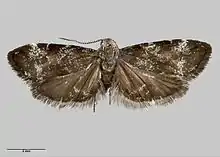| Asterivora tristis | |
|---|---|
 | |
| Scientific classification | |
| Domain: | Eukaryota |
| Kingdom: | Animalia |
| Phylum: | Arthropoda |
| Class: | Insecta |
| Order: | Lepidoptera |
| Family: | Choreutidae |
| Genus: | Asterivora |
| Species: | A. tristis |
| Binomial name | |
| Asterivora tristis | |
| Synonyms[2] | |
| |
Asterivora tristis is a species of moth in the family Choreutidae.[1] It is endemic to New Zealand and has been observed in Tongariro National Park. Adults of this species are on the wing in January.
Taxonomy
This species was first described by Alfred Philpott in 1930, using specimens collected on the slopes of Mount Ruapehu at Tongariro National Park in January, and named Simaethis inspoliata.[3] In 1939 George Hudson discussed and illustrated this species under that name.[4] In 1979 J. S. Dugdale placed this species within the genus Asterivora.[5] In 1988 Dugdale confirmed this placement.[2] The male holotype specimen is held at the Auckland War Memorial Museum.[2]
Description
.jpg.webp)
Philpott described this species as follows:
♂. 10-11 mm. Head and thorax dark brown sprinkled with white. Palpi white annulated with black. Antennae black annulated with white, ciliations in ♂ 2. Abdomen dark brown, segmental divisions whitish. Legs dark brown mixed with white. Forewings with costa moderately arched, apex rounded, termen hardly rounded, oblique; deep blackish fuscous densely sprinkled with bluish white scales which tend to form fasciae at base, 1⁄3 and 3⁄4 ; a short streak of whitish scales along termen above tornus; usually a rather conspicuous white spot on costa at 3⁄4; fringes dark drown, tipped with white at tornus and beneath apex. Hindwings dark purplish fuscous; a very obscure whitish fascia from tornus to about middle of wing, sometimes absent: fringes brown, more or less mixed with white and with a broad purplish fuscous basal band.[3]
This species is similar to A. albifasciata but lacks the distinguishing whitish sub-terminal shade of the later species.[4]
Distribution
This species is endemic to New Zealand and has been observed in Tongariro National Park.[1]
Behaviour
The adults of this species are on the wing in January.[4]
References
- 1 2 3 Gordon, Dennis P., ed. (2010). New Zealand inventory of biodiversity: Kingdom animalia: chaetognatha, ecdysozoa, ichnofossils. Vol. 2. p. 457. ISBN 978-1-877257-93-3. OCLC 973607714. OL 25288394M. Wikidata Q45922947.
- 1 2 3 John Stewart Dugdale (23 September 1988). "Lepidoptera - annotated catalogue, and keys to family-group taxa". Fauna of New Zealand. Department of Scientific and Industrial Research. 14: 114. doi:10.7931/J2/FNZ.14. ISSN 0111-5383. Wikidata Q45083134.
- 1 2 Philpott, Alfred (1930). "New Species of Lepidoptera in the Collection of the Auckland Museum". Records of the Auckland Institute and Museum. 1: 12–13. ISSN 0067-0464. JSTOR 42905932. Wikidata Q58676529.
- 1 2 3 George Vernon Hudson (1939), A supplement to the butterflies and moths of New Zealand, Illustrator: George Hudson, Wellington: Ferguson and Osborn Limited, p. 457, OCLC 9742724, Wikidata Q109420935
- ↑ J. S. Dugdale (July 1979). "A new generic name for the New Zealand species previously assigned to Simaethis auctorum (Lepidoptera: Choreutidae), with description of a new species". New Zealand Journal of Zoology. 6 (3): 461–466. doi:10.1080/03014223.1979.10428386. ISSN 0301-4223. Wikidata Q54576372.